Popular Reads
Top Results
Can't find what you're looking for?
View all search resultsPopular Reads
Top Results
Can't find what you're looking for?
View all search resultsAnalysis: Indonesian Economy: Where do we go from here?
The Indonesian economy, as widely expected, decelerated to 4
Change text size
Gift Premium Articles
to Anyone
T
he Indonesian economy, as widely expected, decelerated to 4.67 percent in the second quarter this year, dragging first semester growth down to only 4.69 percent. The first semester growth figure was posted as the slowest since 2010 had 6.42 percent growth following the global financial crisis. Several indicators actually signaled that the first semester would be a challenging period for President Joko 'Jokowi' Widodo's administration.
In the first half, car and motorcycle sales contracted by 18 percent and 24 percent, translating into only 525,000 cars and 3.2 million motorcycles sold (versus 642,000 units and 4.2 million in the first half of 2014). Car and motorcycle sales are good indicators for predicting Indonesia's economic direction in the near future since it reflected both 'medium to high' and 'medium to low' customer purchasing power. Another good indicator is the retail sales, which interestingly had an upward trend, according Bank Indonesia's (BI) retail sales index. However, at the corporate level, dropping sales were seen in the first half. Based on their financial report, most companies' net profit contracted significantly in the first semester, such as PT Ramayana Lestari Sentosa (RALS), which booked negative 11.9 percent net profits (versus -4.1 percent in the first half of 2014 and 4.7 percent in the first half of 2013), while PT Mitra Adi Perkasa's net profit contracted by 67.8 percent at the same period (versus -28.9 percent in the first half of 2014 and -12.2 percent in the first half of 2012). The bottom line figure was expected to be slightly better during Ramadhan festivities, though still limited, and should be reflected in the third quarter this year. In line with the persistent downward trend of commodity prices, some retailers still struggle with the performance outside of Java, due to people's limited spending.
But what made the market confidence drop in beginning of the year is the slow implementation of the government budget in the first semester. The government had stated that the discussion of the 2015 budget revision and some changes in ministries' nomenclatures contributed a lot to the delay. At the end of the first half, the disbursement of capital spending reached 8.3 percent of the total while total spending disbursement was set at 39 percent.
The first semester performance was below most people's expectations at the beginning of the year. Now the million dollar question is whether the economy will keep decelerating or if it has already reached its bottom. It is worth noting that the current state of the economy is still following a downward cycle. The cycle has already taken place since the second quarter of 2012 or in accordance with lower commodity prices. Bank Indonesia's consumer confidence index (CCI) also confirms that the domestic economy has many challenges ahead.
July's CCI dropped to 109.9 or 1.4 points lower from the previous month and the major driver was the lower Consumer's Expectation Index, which represented consumers and business players' opinions about income, job opportunities and business in the next six months. The index dropped compared to previous months, reflecting a less optimistic opinion about Indonesia's economy in the next six months. Interestingly, the Central Statistics Agency also released a different path to optimism that was depicted by their business tendency index in the third quarter, which is expected to be the higher figure of 106.09 (versus 105.46 in the second quarter of 2015). It means that business players are more optimistic in facing the third quarter compared to the second quarter and it is reflected in almost all sectors but mining and quarrying.
Overall, we think economic growth has started to stabilize and the 4.67 percent year-on-year growth will likely be the bottom. The rebound is expected to kick in the second half of 2015 on the back of investment, driven from the public capital expenditure. The key of the economic rebound is the realization of the government-driven infrastructure projects and the low prices of staple commodities. Both will significantly affect the investment and people's purchasing power this year. We should remember that most people outside Java are hardly affected by the lower commodity prices and their appetite to spend dropped compared to the commodity boom period. The GDP's contraction in several provinces that produce Indonesia's major commodities (such as East Kalimantan, Riau and Western Papua) is proof of people's decreasing spending.
Currently, the tender process for the government's small and medium projects is almost done and ready to be executed in the second semester. On the other hand, private consumption should normalize due to the diminishing base effect of the 2014 national elections and it will also be supported by the regional election-related activities, especially campaigns, in the fourth quarter of 2015. Thus, local administration spending is probably to be mostly spent a month prior to the local elections (there will be around 269 local elections starting this year, lasting until 2017). Previously, the Finance Ministry mentioned that around Rp 273.5 trillion (US$20 billion) in local administrations' spending was still left undisbursed and created the risk of low budget disbursement until end of the year.
In conclusion, we expect that the rebound will likely be lower than anticipated due to the limited time period for the spending and the shortfall risk on the government's revenue that potentially limited the amount available for spending. Furthermore, external risks will still create challenges for investors who want to enter Indonesia in the upcoming period; for instance, China's deceleration, the US' tightening policies and the economic volatility of the eurozone. At this juncture, we believe the economy will reach 4.8 percent to 5 percent this year, though it is more likely that it will be at the lower end of that range.
_________________________
The writer is a senior economist at Bank Mandiri.










